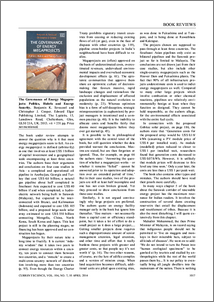Ahuja, Dilip R
(2014)
The Governance of Energy Megaprojects:Politics, Hubris and Energy Security.
Current Science, 106 (7).
pp. 1017-1018.
ISSN 0011-3891
![[img]](http://eprints.nias.res.in/style/images/fileicons/application_pdf.png)  Preview |
|
PDF
2014-Dilip,RA-CurrentScience.pdf
- Published Version
Download (243kB)
|
| Abstract: |
The book under review attempts to
answer the question why is it that most
energy megaprojects seem to fail. An energy
megaproject is defined (arbitrarily)
as one that involves at least US$ 1 billion
of capital investment and a geographical
scale encompassing at least three countries.
The authors base their arguments
and conclusions on four case studies in
Asia – a completed and operational oil
pipeline in Azerbaijan, Georgia and Turkey
that cost US$ 4.6 billion; a natural
gas pipeline about half completed in
Southeast Asia expected to cost US$ 40
billion if and when completed; a hydroelectric
network being built in Sarawak
(Malaysia), but expected to be interconnected
with Brunei, and Kalimantan
(Indonesia) and expected to cost US$ 105
billion; and a proposed large-scale solar
array estimated to cost US$ 550 billion
connecting Mongolia, China, North
Korea, South Korea and Japan. This last
project is still in the planning stages; no
financing has been approved and no construction
has begun. |
| Item Type: |
Journal Paper
|
| Additional Information: |
Copyright belongs to Publisher |
| Subjects: |
School of Natural and Engineering Sciences > Energy |
| Divisions: |
Schools > Natural Sciences and Engineering |
| Date Deposited: |
18 Dec 2014 06:54 |
| Last Modified: |
08 May 2015 10:25 |
| Official URL: |
http://www.currentscience.ac.in/Volumes/106/07/101... |
| Related URLs: |
|
| Funders: |
UNSPECIFIED |
| Projects: |
UNSPECIFIED |
| DOI: |
|
| URI: |
http://eprints.nias.res.in/id/eprint/640 |
Actions (login required)
 |
View Item |


